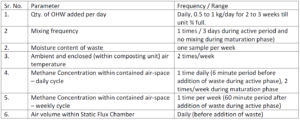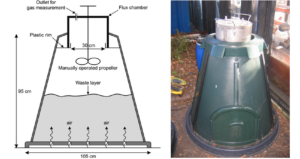Methane Emissions of Daily Dump’s Khamba Home Composting Product
Posted OnThis post summarizes an experimental design brief written by Vivek Gilani of cBalance. The project objective is to conduct testing of methane emissions for Organic Household Waste (OHW) to develop an emission factor for the purposes of Ecolabelling the Daily Dump’s Khamba Home-Composting Product. The methodology used for methane emissions measurement is the Status Flux Chamber Method as described in “Greenhouse gas emissions from home composting of organic household waste.”
The parameters for measurement are described in the table below:

The project time frame would consist of an active period of two to three weeks (with daily addition of OHW and 1 times/3 days mixing frequency) and a maturation period of three weeks (with no addition or mixing of OHW).
The schematics below depict how the experiment would be set up, allowing for adequate customization to accommodate the specific dimensions and design/operational principles of the earthen ‘Gamla’ product.

Data Analysis Protocol and Deliverables:
- Methane concentrations will be analyzed using equipment equivalent to a photo acoustic gas monitor (INNOVA 1312, Lumasense Technologies) or Nondispersive Infrared Sensor (NDIR) sensor, which measures concentrations in real time and has high accuracy over a broad concentration range and with minimal re-calibration requirements during the project period of 6 weeks. The calibration shall be in the range of 0.03–50 ppmv for methane measurements.
- The data deliverable for the project shall consist of Emissions Flux (ECH4) (in g/h) of CH4 plotted against time (for the entire duration of the project) where ECH4 is calculated using the following relationship:
ECH4 = dCCH4/dt * Vtotal,
Where Vtotal is the volume of the flux chamber plus the volume of the head space in the composting unit, which decreases over time as the unit is filled with waste.
- The data should finally be converted to yield total methane emissions (mass basis) for the total composting cycle by integrating under the concentration vs. time curve for the entire project period (6 weeks)
Other notes:
- The concentrations of gases inside the composting unit are expected to be elevated because of the build-up under the lid. Therefore, before measuring the emission of gases, the air in the composting units should be exchanged to start the measurement as close to ambient concentrations as possible.
- The flux chamber, when placed on top of the composting unit, is expected to witness the emission of gases from the compost material, resulting in a linear increase of the gas concentration over the time period of measurement.
- It is assumed that the entire volume of air over the waste is totally mixed during emission measurements. This should be ensured by mixing the air manually with a propeller.
- The head space volume must be estimated for every emission measurement by measuring the height of the waste in the composting units.
- The inlet to the gas measurement equipment (analyzer) should be equipped with a water filter (such as a membrane separator) to ensure that no moisture is transferred to the measuring
chamber. - The CH4 emissions are expected to be mostly affected by mixing the material. The emission of CH4 is anticipated to increase significantly after mixing the material but also decrease drastically to the original level within the first hour. This must be borne in mind when mixing the material and then replacing the static flux chamber swiftly to ensure measurement of gas concentration immediately after mixing.
The original report can be read here.